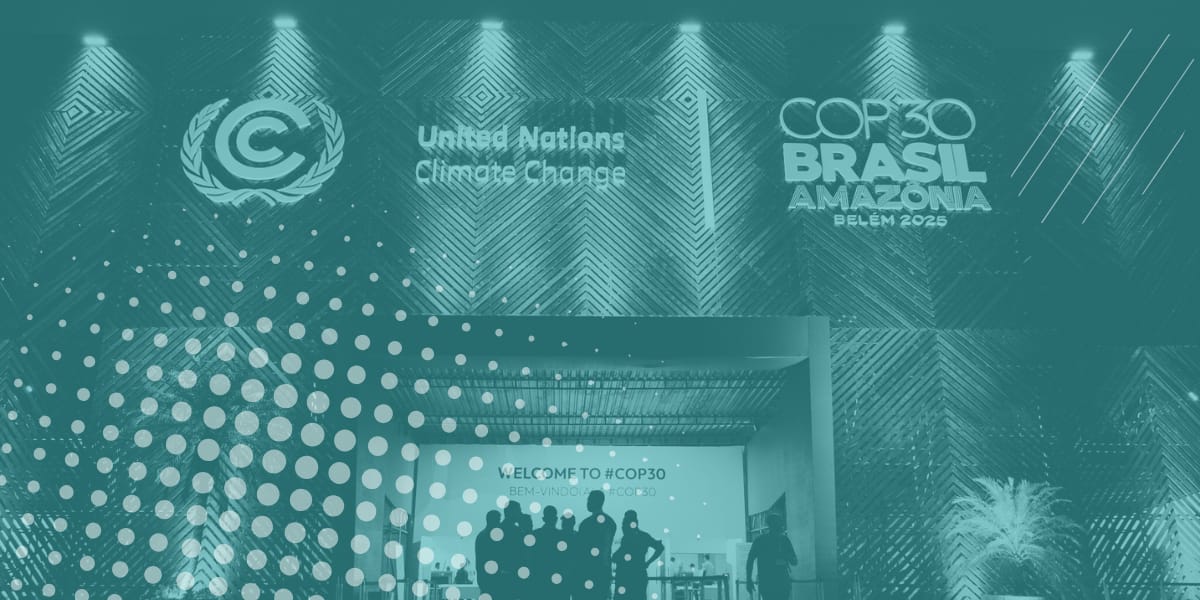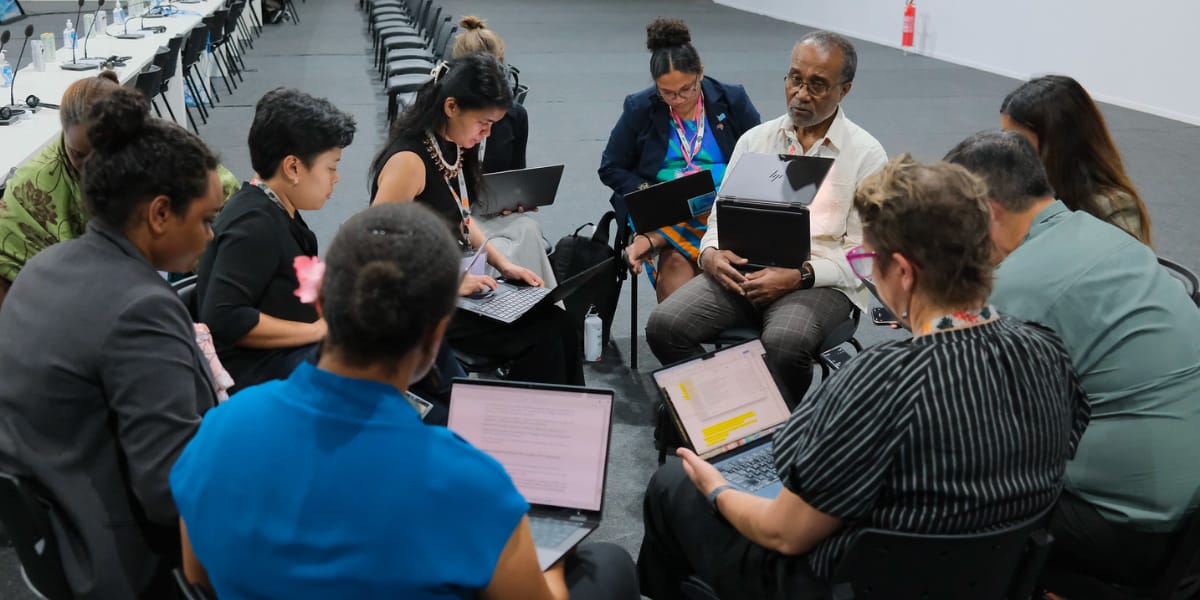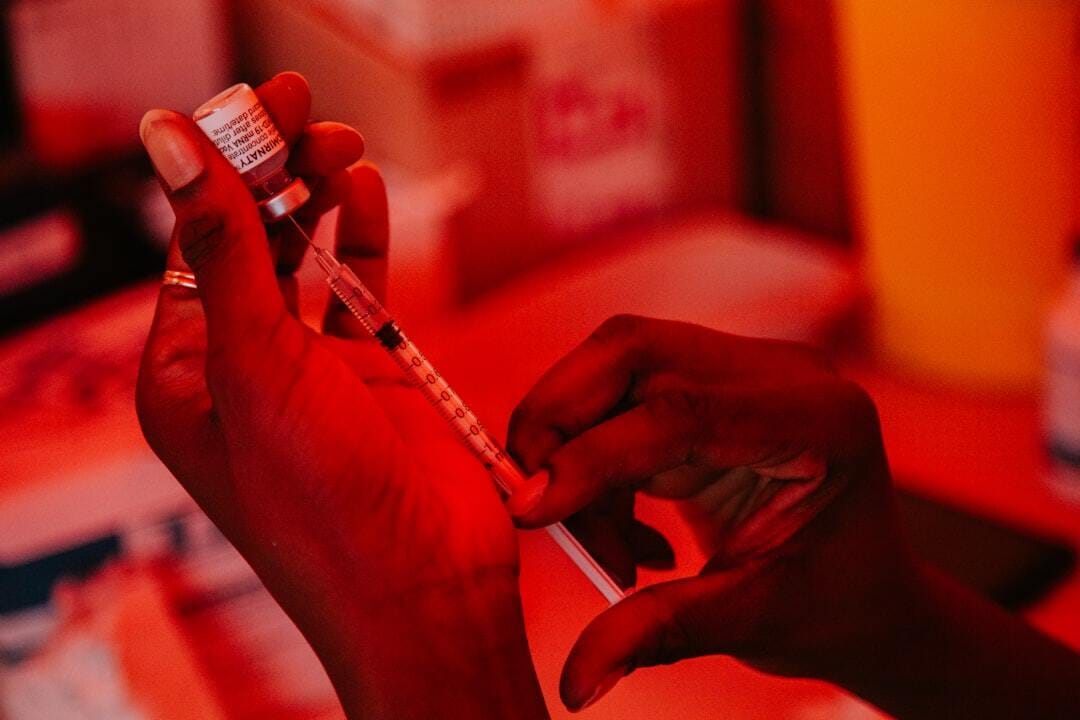
Around the venue at COP30 in the Brazilian Amazon. Source: UN Climate Change / Kiara Worth
In this edition: 💰 Finance The Rockefeller Foundation, Bloomberg Philanthropies, and others pledge US$300mn to tackle climate health threats, Green Climate Fund trumpets ‘country platforms’ & more. 🏛️ Policy Global Goal on Adaptation indicators adoption hangs in the balance at COP30, US FEMA Acting Administrator resigns & more. 🤖 Tech Experts expound on adaptation tracking benefits of Earth Observation tech, satellite imaging start-up raises US$6.8mn & more. 📝 Research Another round-up of papers and journal articles on all things climate adaptation.

Philanthropies Launch $300mn Funding Initiative to Tackle Climate-Linked Health Crisis
An alliance of philanthropies has pledged US$300mn to combat climate-related public health threats, as extreme weather and rising temperatures take an increasing toll on the world’s most vulnerable populations.
The initiative — backed by over 35 organizations including The Rockefeller Foundation, Bloomberg Philanthropies, and the Children’s Investment Fund Foundation — will start by financing health solutions that address sweltering temperatures, air pollution, and climate-sensitive diseases. Extreme heat alone is now claiming 546,000 lives a year, while the global risk of dengue transmission has increased by up to 49% since the 1950s, according to the recent 2025 Lancet Countdown Report on Health and Climate Change.
“Climate change is the gravest health threat of our time, and no single organization, community, or country can tackle it alone,” says Naveen Rao, Senior Vice President of Health at The Rockefeller Foundation. “By coming together to align our priorities and combine our resources, this coalition can accelerate solutions faster, reach more communities, and achieve greater impact.”
The US$300mn commitment aims to support the newly unveiled Belém Health Action Plan, which was released at COP30 last week (read more in the ‘Policy’ section below). To this end, the philanthropies will work to align and scale funding efforts by attracting long-term investment from public, private, and multilateral sources.
In Brief
CAF, the Development Bank of Latin America and the Caribbean, launched a US$100mn resilience bond at COP30 — the first of its kind in the region. Issued in partnership with the UN Office for Disaster Risk Reduction (UNDRR), the instrument is aligned with the Climate Bonds Resilience Taxonomy, the same framework that underpins the Tokyo Metropolitan Government’s recent €300mn (US$350mn) placement. Proceeds from the bond will be invested in climate-resilient projects supporting water and sanitation, drainage and flood control, nature-based adaptation solutions, and more. (UNDRR)
The Green Climate Fund — the world’s largest fund dedicated to climate action — announced that 14 developing countries or regions had pledged to create new ‘country platforms’ to better align climate and nature finance with national priorities. The move expands a model pioneered by Brazil and the Caribbean, transforming adaptation and mitigation financing from a stop-start series of disjointed initiatives to a more streamlined approach — one better suited to attracting public and private investments at scale. Colombia, Cambodia, Mongolia, and Kazakhstan are among the countries that are developing new platforms. (Green Climate Fund)
Adaptation-focused private equity outfit The Lightsmith Group has secured financial backing for its SCALE project — a “virtual green bank” offering equity, credit, and technical assistance to companies providing adaptation and resilience technologies, particularly in developing countries. Announced last year, SCALE initially received backing from USAID before the Trump administration dismantled the agency. New support is being offered by the Global Environment Facility (GEF) and Norway’s Ministry of Foreign Affairs. The latter is committing up to NOK 17mn (US$1.7mn), with GEF support coming through its Challenge Program for Adaptation Innovation and other funds. (The Lightsmith Group)
A coalition of NGOs has launched the Fostering Investable National Planning and Implementation (FINI) for Adaptation and Resilience. Backed by the Atlantic Council’s Climate Resilience Center and the Natural Resources Defense Council, among others, the new initiative aims to strengthen connections between public and private financial institutions and unlock more than US$1trn in adaptation investments by 2028. (Atlantic Council)
Half of the US$1.3trn in annual international climate finance by 2035 called for under the recently issued “Baku to Belém Roadmap” could be supplied by private investors, a new report from the Independent High-Level Expert Group on Climate Finance claims. However, annual adaptation finance needs — estimated to be some US$400bn a year —may be harder to meet using private sources given the challenges generating capturable financial returns from adaptation investments. To close the gap, the expert group proposes reforming debt and fiscal frameworks, integrating adaptation into country-led investment platforms, and expanding concessional finance via multilateral banks, among other measures. (Independent High-Level Expert Group on Climate Finance)
Less than US$4bn of the US$42.2bn invested in health and climate initiatives by major development funders between 2019 and 2023 went toward climate adaptation, according to a new report commissioned by the Asian Infrastructure Investment Bank and Gavi. Overall, less than 0.5% of total global climate finance supports human health interventions, the study adds. Of current health investments supporting adaptation, immunization and health infrastructure are leading the way, with up to US$36.50 of every US$100 spent on these activities going toward addressing growing climate-related disease burdens. (Asian Infrastructure Investment Bank)
The WWF is urging COP30 negotiators to integrate climate and nature-based solutions into financial resilience strategies, warning that the escalating costs of climate-driven disasters are eroding the foundations of global insurance markets. In a new policy brief, the NGO highlights a surge in uninsured losses across major economies and a leap in premium costs as signs that drastic reforms are necessary to secure financial system stability. Among its proposed fixes, the WWF cites emissions cuts, ecosystem restoration, and regulatory reforms. (WWF)
📰 20% Of Climate Proof Readers Are Paying For The Other 80%
If you’re reading this, then it’s thanks to one of the 200+ paying Climate Proof members who support our news-gathering, data-mining, and original reporting.
Paying members keep the lights on at Climate Proof HQ. Don’t let them shoulder the burden alone. Upgrade today. It’s only $9/month or $89/year.
With thanks,
Louie Woodall
Editor

Adaptation Indicators Negotiations Teeter at COP30
Efforts to establish a common language for measuring adaptation progress risk running aground at COP30 after a fractious back-and-forth among parties on a key negotiation text.
Early-stage talks on adopting 100 adaptation indicators at COP30 last week highlighted serious fissures between negotiating parties, raising doubts as to whether the list would be approved at this summit at all, according to Cristina Rumbaitis del Rio, Senior Advisor at the UN Foundation.
A draft text released Saturday includes three options for concluding the indicator work program: one, adopting the list of indicators in full or in part; two, postponing approval until 2027; or three, recognizing the indicators only as a “knowledge product” and bringing the process to a halt.
Experts fear that any outcome besides formal adoption of the indicators could kill momentum towards the Global Goal on Adaptation (GGA) — the Paris Agreement objective that commits nations to strengthening their resilience and reducing their vulnerability to climate shocks. “There is a real risk that if the GGA is delayed, any political attention it may have had will be gone,” Ana Mulio Alvarez, Policy Advisor at think-tank E3G, told Climate Proof.
Countries are at loggerheads over the question of adaptation finance in the context of the GGA. The batch of provisional indicators, hashed out by a technical expert group over the past year, includes 11 covering “implementation”. These ask that countries measure the amount of climate finance they receive for adaptation and their annual adaptation expenditures, among other things.

Informal networking at COP30. Source: UN Climate Change
However, parties belonging to the Least Developed Countries (LDC) group do not want to adopt indicators tracking national expenditures and domestic adaptation budgets, in part because they believe this data could be used by rich countries to throttle back international adaptation finance. Similarly, the African Group of Negotiators (AGN) want the “implementation” indicators to align closely with Paris Agreement language, which says that developed countries shall provide financial resources to assist with poorer nations’ adaptation efforts. The AGN is also pushing for a 2-year delay in adopting the indicators.
“[Developed countries] want to capture all the different aspects of finance to support implementation — including domestic budgets. Developing countries don’t want [that] because they really see this [the indicators] as a tool for accountability, and accountability for finance provision and watering down the focus on the provision from developed to developing [countries] would set a bad precedent,” Rumbaitis told Climate Proof.
Another sticking point is the inclusion or exclusion of an adaptation finance target. While many poorer countries want any agreement on the indicators to include either a target or a strong call for doubling or tripling adaptation finance from rich nations, developed countries are opposed. European Union negotiators are against attaching a finance target, saying that this would reopen the climate finance agreement forged at last year’s COP in Kazakhstan.
In Brief
Brazil debuted a landmark climate-health adaptation plan at COP30, rallying over 80 nations and institutions behind a voluntary framework to build climate-resilient health systems. However, the initiative launched without financial commitments from endorsing countries, raising doubts about implementation. The Belém Health Action Plan lays out 60 recommendations — from early warning systems to infrastructure upgrades — targeting the 3.3 billion people at risk from climate-driven health impacts. While backed by key players like France, Japan, and the World Health Organization, critics warn that without massive public funding and political will, the Belém plan may follow the fate of previous COP health pledges that failed to translate into action. (Health Policy Watch)
An alliance of far-right and center-right lawmakers in the European Parliament voted to water down corporate climate and sustainability reporting requirements last Thursday, in a move that could hinder efforts to promote climate risk management and adaptation throughout the private sector. The center-right European People’s Party (EPP) broke with traditional centrist allies to push through the deregulatory ‘omnibus’ package — which commits the European Parliament to significantly roll back both the Corporate Sustainability Reporting Directive (CSRD) and the Corporate Sustainability Due Diligence Directive (CSDDD) during upcoming trilogue negotiations with the European Council and Commission. Parliament’s agreed-on stance would exempt around 92% of EU firms from the CSRD reporting requirements, capturing only those with more than 1,750 full-time employees and at least €450mn (US$522mn) in net turnover. Companies in scope of the CSDDD would not have to put together climate transition plans, and EU-wide civil penalty provisions for breaching the rules would be scrapped. Trilogue negotiations are slated to take place imminently, with policymakers looking to finalize the softened rules by year-end. (Real Economy Progress)
David Richardson has stepped down as Acting Administrator of the US Federal Emergency Management Agency (FEMA) amidst ongoing uncertainty over the disaster response body’s future under the Trump administration. Richardson, a former Marine with no background in emergency management, had sparked internal concern after taking over in May, replacing Cameron Hamilton, who was ousted following his defense of FEMA’s role in responding to catastrophes. (New York Times)
The US Department of Agriculture (USDA) identified federal grants for termination using keywords and phrases including “climate modeling”, “biodiversity and ecosystem resilience related to climate change”, and “climate adaption [sic] and resilience planning”, according to internal memos obtained by advocacy group FarmSTAND and reviewed by Reuters. These searches contributed to the scrapping of some 600 grants worth over US$3bn earlier this year, data published on the Department of Government Efficiency website shows. The canceled grants included funding for school food programs, technical support for sustainable farming, and nutrition aid. The USDA documents were acquired by FarmSTAND as part of its lawsuit against the agency over the grant terminations, alongside legal groups Earthjustice and Farmers Justice Center. (Reuters)
Climate change is driving Iowa’s insurance market into crisis mode, according to a new statement from 179 scientists across 26 Iowa colleges and universities. The coalition warns that heavier rainfall and extreme heatwaves are fueling property damage, inflating premiums, and prompting insurers to abandon the state altogether. With reinsurance and inflation pressures mounting, policyholders and taxpayers alike are footing the bill, especially in agriculture, where federal crop insurance subsidies now cost around US$10bn annually. Experts called for urgent investment in climate resilience, including tougher building codes and modernized roofing standards, arguing that without adaptation — and emissions cuts — costs will only rise. (Iowa Climate Statement)

Space Data Could Be the Missing Link in Tracking Global Climate Adaptation Progress
Satellite data could support tracking of adaptation progress — yet its potential remains unrealized, according to climate and space science experts.
In a new paper published in npj Climate and Atmospheric Science, they argue that spaced-based Earth Observation (EO) technologies can provide “objective, repeatable, and globally consistent data” to populate the indicators being developed for the Global Goal on Adaptation under the Paris Agreement (read more in the ‘Policy’ section above).
Case studies shared in the paper reveal how EO is already informing adaptation efforts. For example, satellite-derived water productivity data is already guiding irrigation strategies in Africa; while data from meteorological satellites is being used to monitor conditions that give rise to increased agricultural pest risks — like sudden heavy rainfall events.
The authors recommend that countries take EO data into account when selecting indicators at COP30, and that EO experts and space agencies be included in discussions on how to set adaptation targets at both global and national levels. They also call on EO agencies to “operationalize” EO-based adaptation data so it can be useful to end-users who need to map adaptation progress.
However, the authors also note that EO data alone is insufficient. It must be integrated with socio-economic and “ground truth” information to reflect local realities and prevent a skewed picture of vulnerability from being relayed to decision-makers, they write.
In Brief
Soil carbon tech company Varaha has secured a US$30mn commitment from asset manager Mirova to expand its climate resilient agriculture business in the states of Haryana and Punjab in India. The financing will support over 337,000 smallholder farmers in adopting regenerative practices like reduced tillage and residue management across 675,000 hectares, improving soil health, conserving water, and reducing emissions. The deal marks Mirova’s largest nature-based carbon investment to date and underscores its strategy to scale climate-adaptive agriculture and build rural resilience across Asia. (Mirova)
Satellite imaging start-up Extellis has raised US$6.8mn in seed funding to launch its first orbital demo and roll out its imaging services. The company, which uses a patented metasurface antenna technology developed at Duke University and backed by the Defense Advanced Research Projects Agency (DARPA), aims to make reliable, high-resolution Earth observation affordable at industrial scale. The funding round was led by Oval Park Capital, an early-stage venture firm. (Extellis)
Researchers at the University of Manchester have upgraded one of the world’s leading climate models to better simulate how cities both influence and are affected by climate change. Published in the Journal of Advances in Modeling Earth Systems, the study integrates Local Climate Zones (LCZ), a detailed classification of urban form, into the Community Earth System Model (CESM), replacing outdated “one-size-fits-all” city categories. By capturing the diverse makeup of urban sprawls, the enhanced model significantly improves simulations of urban heat dynamics. This breakthrough could support policymakers in designing targeted climate adaptation strategies for heat-prone cities. (University of Manchester)

RESEARCH
Earth observations for climate adaptation: tracking progress towards the Global Goal on Adaptation through satellite-derived indicators (npj Climate and Atmospheric Science)
The power of hourly weather data: Observed air temperature climate trends for pragmatic decision-making (PLOS Climate)
Strengthening climate resilience through the Global Goal on Adaptation (Council on Energy, Environment and Water)
Climate change and epidemics: 2025 synthesis report (Climade)
Roadmap to financing adaptation and resilience in developing countries (World Resources Institute)
Human-wildlife conflict is amplified during periods of drought (Science Advances)
Thanks for reading!
Louie Woodall
Editor




